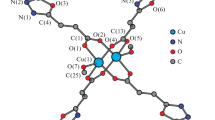Summary
The reaction of CuL2 where L is ethylacetoacetate (EAA),o-hydroxyacetophenone (OHAP) ando-hydroxycrotonophenone (OHCP), with trichloroacetic acid (TCA) in chloroform yielded mixed ligand complexes of the type CuL(TCA). They have sub-normal magnetic moments and their ligand field spectra suggest a square-planar configuration. Their i.r. spectra indicate bidentate chelating carboxylate groups. The mixed ligand complexes CuL(OXINE), where LH is salicylaldehyde (SAL) or salicylaldimine (SALIMINE), have been also obtained. The treatment of CuL(OXINE) where L is SAL, SALIMINE, ACAC or salicylaldehydephenylhydrazone (SALPHN) with TCA yielded Cu(OXINE)(TCA). On reacting Cu(OHAP)(SAL) and Cu(SAL)(ACAC) with TCA, Cu(SAL)(TCA) and Cu(ACAC)(TCA), respectively, were produced. The displacement of coordinated L from CuL(TCA) by other bidentate chelating ligands in benzene has been also studied. Thus, EAA in Cu(EAA)(TCA) was replaced by OHAP, and SAL in Cu(SAL)(TCA) by OHCP. The reactions reveal the following orders of Cu-O strength: TCA > OXINE > SALIMINE > ACAC > OHCP > SAL > OHAP > EAA and OXINE > SALPHN.
Similar content being viewed by others
References
M. M. Aly,J. Inorg. Nucl. Chem. Lett., 9, 223 (1973).
M. M. Aly and A. I. El-Said,J. Inorg. Nucl. Chem., 43, 45 (1981).
M. M. Aly,Z. Naturforsch. 33b, 906 (1978).
L. J. Boucher and M. O. Farrel,J. Inorg. Nucl. Chem., 35, 3731 (1973).
M. N. Hughes,The Inorganic Chemistry of Biological Processes, John Wiley, London, 1972.
D. P. Graddon and G. M. Mockler,Aust. J. Chem., 21, 617 (1968).
M. Palaniandavar and C. Natarajan,Aust. J. Chem., 33, 729 (1978).
U. Doraiswamy and P. K. Bhattacharya,J. Inorg. Nucl. Chem., 37, 1665 (1975).
P. K. Bhattacharya and B. T. Thaker,J. Inorg. Nucl. Chem., 37, 615 (1975).
R. C. Aggarwal, R. A. Rai and T. R. Rao,Proc. XXth ICC, Abstracts, p. 174, Calcutta, India, Dec. 1979.
J. Ferguson,Progr. Inorg. Chem., 12, 273 (1970).
A. B. P. Lever and D. Ogden,J. Chem. Soc., 2041 (1967).
K. S. Patel and J. A. Faniran,J. Inorg. Nucl. Chem., 38, 1001 (1976).
K. S. Patel, J. A. Faniran and A. Earnshaw,J. Inorg. Nucl. Chem., 38, 352 (1967).
M. Palaniandavar and Douglas X. West, to be published.
Author information
Authors and Affiliations
Rights and permissions
About this article
Cite this article
Palaniandavar, M. Carboxylate mixed ligand complexes of copper(II) with some chelating carbonyl and imine ligands and their reactivity. Transition Met Chem 8, 14–16 (1983). https://doi.org/10.1007/BF00618789
Received:
Issue Date:
DOI: https://doi.org/10.1007/BF00618789



